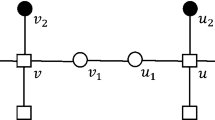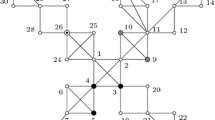Abstract
The study of a variation of the marking game, in which the first player marks vertices and the second player marks edges of an undirected graph was proposed by Bartnicki et al. (Electron J Combin 15:R72, 2008). In this game, the goal of the second player is to mark as many edges around an unmarked vertex as possible, while the first player wants just the opposite. In this paper, we prove various bounds for the corresponding graph invariant, the vertex-edge coloring number \({\text {col}}_\mathrm{ve}(G)\) of a graph G. In particular, every (finite or infinite) graph G whose edges can be oriented in such a way that the maximum out-degree is bounded by an integer d has \({\text {col}}_\mathrm{ve}(G)\le d+2\). We investigate this invariant in (classes of) planar graphs, including some infinite lattices. We present a close connection between the vertex-edge coloring number of a graph G and the game coloring number of the subdivision graph S(G). In our main result, we bound the vertex-edge coloring number in complete graphs from below and from above, and while \({\text {col}}_\mathrm{ve}(K_n)\le \lceil \log _2{n}\rceil +2\), the difference between the upper and the lower bound is roughly \(\log _2(\log _2 n)\). The latter results are, in fact, true for any multigraph whose underlying graph is \(K_n\).




Similar content being viewed by others
References
S.D. Andres, A. Theuser, Note on the game colouring number of powers of graphs, Discuss. Math. Graph Theory 36 (2016) 31–42.
T. Bartnicki, B. Brešar, J. Grytczuk, M. Kovše, Z. Miechowicz, I. Peterin, Game chromatic number of Cartesian product graphs, Electron. J. Combin. 15 (2008) #R72, 13 pp.
T. Bartnicki, J. Grytczuk, H. A. Kierstead, X. Zhu, The map coloring game, Amer. Math. Monthly 14 (2007) 793–803.
H.L. Bodlaender, On the complexity of some coloring games, Internat. J. Found. Comput. Sci. 2 (1991) 133–147.
C. Charpentier, S. Dantas, C. de Figueiredo, A. Furtado, S. Gravier, On Nordhaus-Gaddum type inequalities for the game chromatic and game coloring numbers, Discrete Math. 342 (2019) 1318–1324.
M. Chrobak, D. Eppstein, Planar orientations with low out-degree and compaction of adjacency matrices, Theoret. Comput. Sci. 86 (1991) 243–266.
R. Diestel, Graph Theory, fourth ed., in: Graduate Texts in Mathematics, vol. 173, Springer, Heidelberg, 2010.
G.A. Dirac, Some theorems on abstract graphs, Proc. Lond. Math. Soc. 2 (1952) 69–81.
P. Erdős, A. Hajnal, On chromatic number of graphs and set-systems, Acta Math. Acad. Sci. Hungar 17 (1966) 61–99.
A. Frank, A. Gyárfás, How to orient the edges of a graph ?, Combinatorics (Proc. Fifth Hungarian Colloq., Keszthely, 1976), Vol. I, (1978) 353–364, North-Holland, Amsterdam-New York, 1978.
M. Gardner, Mathematical games, Scientific American 244 (1981) 18–26.
H. Kierstead, B. Mohar, S. Špacapan, D. Yang, X. Zhu, The two-coloring number and degenerate colorings of planar graphs, SIAM J. Discrete Math. 23 (2009) 1548–1560.
H.A. Kierstead, T. Trotter, Competitive colorings of oriented graphs, Electron. J. Combin. 8 (2001) #R12, 15pp.
H.A. Kierstead, D. Yang, Very asymmetric marking games, Order 22 (2005) 93–107.
E. Sidorowicz, The game chromatic number and the game colouring number of cactuses, Inform. Process. Lett. 102 (2007) 147–151.
D. Yang, X. Zhu, Activation strategy for asymmetric marking games, European J. Combin. 29 (2008) 1123–1132.
X. Zhu, The game coloring number of planar graphs, J. Combin. Theory Ser. B 75 (1999) 245–258.
X. Zhu, Refined activation strategy for the marking game, J. Combin. Theory ser. B 98 (2008) 1–18.
Acknowledgements
We are grateful to both anonymous referees for their valuable suggestions.
This work was performed with the financial support of the bilateral project “Distance-constrained and game colorings of graph products” (BI-FR/18-19-Proteus-011). BB and TG acknowledge the financial support from the Slovenian Research Agency (research core funding No. P1-0297 and project Contemporary invariants in graphs No. J1-9109).
Author information
Authors and Affiliations
Corresponding author
Additional information
Communicated by Torsten Ueckerdt.
Publisher's Note
Springer Nature remains neutral with regard to jurisdictional claims in published maps and institutional affiliations.
Rights and permissions
About this article
Cite this article
Brešar, B., Gastineau, N., Gologranc, T. et al. On a Vertex-Edge Marking Game on Graphs. Ann. Comb. 25, 179–194 (2021). https://doi.org/10.1007/s00026-021-00524-9
Received:
Accepted:
Published:
Issue Date:
DOI: https://doi.org/10.1007/s00026-021-00524-9




